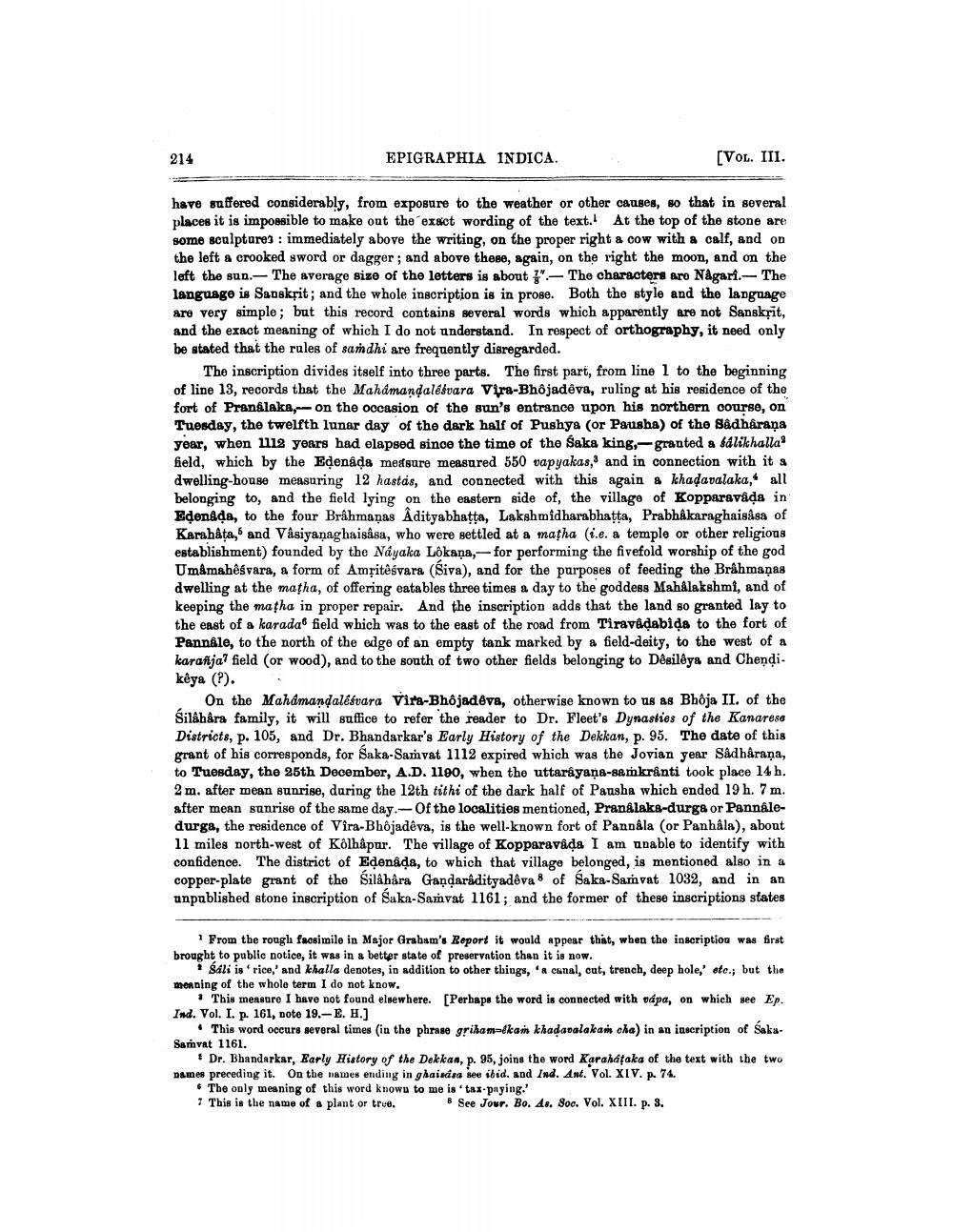________________
214
EPIGRAPHIA INDICA.
[VOL. III.
have suffered considerably, from exposure to the weather or other causes, so that in several places it is impossible to make out the exact wording of the text. At the top of the stone are some sculptures : immediately above the writing, on the proper right a cow with a calf, and on the left a crooked sword or dagger; and above these, again, on the right the moon, and on the left the sun.- The average size of the letters is about 1".- The characters are Nagari.- The language is Sanskrit; and the whole inscription is in prose. Both the style and the language are very simple; but this record contains several words which apparently are not Sanskrit, and the exact meaning of which I do not understand. In respect of orthography, it need only be stated that the rules of sandhi are frequently disregarded.
The inscription divides itself into three parts. The first part, from line 1 to the beginning of line 13, records that the Mahamandalesvara Vira-Bhojadêva, ruling at his residence of the fort of Pranalaka,-- on the occasion of the sun's entrance upon his northern course, on Tuesday, the twelfth lunar day of the dark half of Pushya (or Pausha) of the Sådhåraņa year, when 1112 years had elapsed since the time of the Saka king,- granted a falikhalla field, which by the Edenåda measure measured 550 vapyakas, and in connection with it a dwelling-house measuring 12 hastas, and connected with this again & khadavalaka, all belonging to, and the field lying on the eastern side of the village of Kopparavada in Edonada, to the four Brahmaņas Adityabhatta, Lakshmidharabhatta, Prabhakaraghaisasa of Karahata, and Våsiyanaghaisasa, who were settled at a matha (i.e. a temple or other religious establishment) founded by the Nayaka Lôkana,- for performing the fivefold worship of the god Umamahêśvara, a form of Amritêśvara (Siva), and for the purposes of feeding the Brahmaņas dwelling at the matha, of offering eatables three times a day to the goddess Mahalakshmi, and of keeping the matha in proper repair. And the inscription adds that the land so granted lay to the east of a karada field which was to the east of the road from Tiravidabida to the fort of Pannale, to the north of the edge of an empty tank marked by a field-deity, to the west of a karañjal field (or wood), and to the south of two other fields belonging to Dêsilêya and Chendi. kêya (?).
On the Mahamandalesvara Vira-Bhojadeva, otherwise known to us as Bhoja II. of the Śilâhåra family, it will suffice to refer the reader to Dr. Fleet's Dynasties of the Kanarese Districts, p. 105, and Dr. Bhandarkar's Early History of the Dekkan, p. 95. The date of this grant of his corresponds, for Saka-Samvat 1112 expired which was the Jovian year Sådhåraņa, to Tuesday, the 25th December, A.D. 1190, when the uttarayaņa-samkrinti took place 14 h. 2 m. after mean sunrise, during the 12th tithi of the dark half of Pausha which ended 19 h. 7 m. after mean sunrise of the same day. Of the localities mentioned, Prandlaks-durga or Pannaledurga, the residence of Vira-Bhôjadêva, is the well-known fort of Pannala (or Panhala), about 11 miles north-west of Kolhapur. The village of Kopparavada I am unable to identify with confidence. The district of Edenada, to which that village belonged, is mentioned also in a copper-plate grant of the Silâhâra Gandaradityadeva 8 of Saka-Samvat 1032, and in an unpublished stone inscription of Saka-Samvat 1161; and the former of these inscriptions states
From the rough facsimile in Major Graham's Report it would appear that, when the inscription was first brought to public notice, it was in a better state of preservation then it is now.
• sali is rice,' and khalla denotes, in addition to other things, a canal, cut, trench, deep hole,' etc.; but the meaning of the whole term I do not know.
• This measure I have not found elsewhere. [Perhaps the word is connected with vápa, on which see Ep. Ind. Vol. I. p. 161, note 19.-E. H.]
• This word occurs several times in the phrase griham=&kan khadadalakam cha) in an inscription of SakaSavat 1161.
+ Dr. Bhandarkar, Early History of the Dekkan, p. 95, joins the word Karahataka of the text with the two Dames preceding it. On the names ending in ghaisasa see ibid. and Ind. Ant. Vol. XIV. p. 74.
. The only meaning of this word knowu to me is'tax paying.' . This is the name of a plant or tree. & See Jour. Bo. 48. Soc. Vol. XIII. p. 3.




